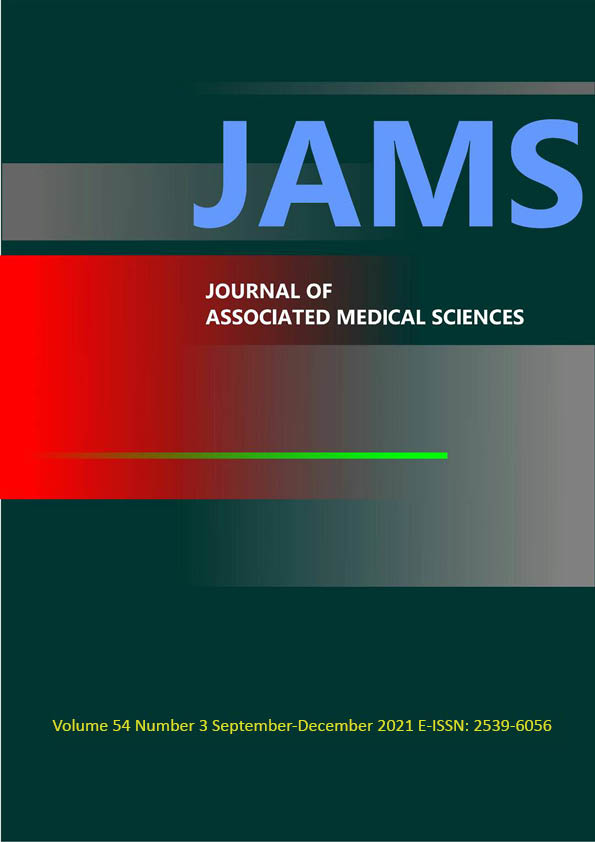Evaluation of two beam-matched linear accelerators for volumetric modulated arc therapy
Main Article Content
Abstract
Background: Currently, Mahavajiralongkorn Thanyaburi Hospital has two linear accelerators (LINACs) of identical models and brands with volumetric modulated arc therapy (VMAT) capability. Since two identical LINAC systems have been installed for two years, it is of great interest to determine beam-matching techniques in order to interchange ongoing irradiated patients between the two LINACs without re-planning if any malfunction of one machine occurs.
Objectives: This study aimed to verify the dosimetric accuracy of beam-matching using VMAT plans after completing the extended beam-matching.
Materials and methods: After completing the acceptance test and initial vendor-recommended beam-matching test, the extent of beam-matching was measured to evaluate the level of beam matching in both LINACs. The original LINAC (LINAC 1) photon beams were selected as the reference for beam tuning of the second LINAC (LINAC 2). Planar dose measurements of head and neck, thorax, and pelvis regions were collected from 30 retrospective cancer patients. The VMAT plans were generated in the Monaco Treatment Planning System (TPS) using a 6 MV photon beam model. TPS doses calculated by LINAC 1 were used as a reference for all measurements. The LINAC 1’s verification plans were irradiated in both LINACs by doing the machine override option available in LINAC 2 consoles. All of the VMAT plans were measured using the Octavius4D dosimetry system. The data of Octavius measurement were compared with the TPS calculated planar doses with gamma criteria of 3% dose difference, and 3 mm distance to agreement (3%/3mm). In addition, the statistically significant differences for gamma passing rates of Octavius measurements between two LINACs was analyzed using a paired sample t-test at a 95% confidence interval (CI).
Results: For all thirty cases, the gamma passing rates of Octavius measurements on two beam-matched LINACs were higher than 95% with 3%/3mm gamma criteria. The mean gamma passing rates of LINAC 1 and LINAC 2 were 96.2±0.8% and 96.3±0.8%, respectively. There was no statistical difference in the gamma passing rates between LINAC 1 and LINAC 2 (p-value = 0.094).
Conclusion: The beam-matched LINACs showed good agreement between measurements and TPS calculations for VMAT plans. Insignificant differences in gamma passing rates between two LINACs prove the viability of interchanging VMAT patients between two beam-matched LINACs without re-planning VMAT plans to manage the machine downtime.
Article Details

This work is licensed under a Creative Commons Attribution-NonCommercial-NoDerivatives 4.0 International License.
Personal views expressed by the contributors in their articles are not necessarily those of the Journal of Associated Medical Sciences, Faculty of Associated Medical Sciences, Chiang Mai University.
References
Marshall MG. Matching the 6-MV photon beam characteristics of two dissimilar linear accelerators. Med Phys. 1993; 20: 1743-6.
Watts RJ. Comparative measurements on a series of accelerators by the same vendor. Med Phys. 1999; 26: 2581-5.
Muñoz L, Kron T, Petasecca M, Bucci J, Jackson M, Metcalfe P, et al. Consistency of small-field dosimetry, on and off axis, in beam-matched linacs used for stereotactic radiosurgery. J Appl Clin Med Phys. 2021; 22: 185-93.
Hrbacek J, Depuydt T, Nulens A, Swinnen A, Van Den Heuvel F. Quantitative evaluation of a beam-matching procedure using one-dimensional gamma analysis. Med Phys. 2007; 34: 2917-27.
Bhangle J, Sathiya Narayanan V, Kumar N, Vaitheeswaran R. Dosimetric analysis of beam-matching procedure of two similar linear accelerators. J Med Phys. 2011; 36: 176-80.
Beyera GP. Commissioning measurements for photon beam data on three TrueBeam linear accelerators, and comparison with Trilogy and Clinac 2100 linear accelerators. J Appl Clin Med Phys. 2013; 14: 273-88.
Krishnappan C, Radha CA, Subramani V, Gunasekaran MK. Is the dose distribution distorted in IMRT and RapidArc treatment when patient plans are swapped across beam-matched machines? J Appl Clin Med Phys. 2016; 17: 111-23.
Ashokkumar S, Ganesh KM, Ramalingam K, Karthikeyan K, Jagadheeskumar N. Dosimetric validation of volumetric modulated arc therapy with three 6MV beam-matched linear accelerators. Asian Pacific J Cancer Prev. 2017; 18: 3439-44.
Xu Z, Warrell G, Lee S, Colussi V, Zheng Y, Ellis R, et al. assessment of beam-matched linacs quality/accuracy for interchanging SBRT or SRT patient using VMAT without re-planning. J Appl Clin Med Phys. 2019; 20: 68-75.
Rijken J, Schachenmayr H, Crowe S, Kairn T, Trapp J. Distributive quality assurance and delivery of stereotactic ablative radiotherapy treatments amongst beam matched linear accelerators: A feasibility study. J Appl Clin Med Phys. 2019; 20: 99-105.
Ghazal M, Södergren L, Westermark M, Söderström J, Pommer T. Dosimetric and mechanical equivalency of Varian TrueBeam linear accelerators. J Appl Clin Med Phys. 2020; 21: 43-53.
Donmoon T, Wattanachaiyasit S, Kaewboonperm U, Meennuch E, Klaitong C. Beam matching of two linear accelerators, identical model and brand. In: Journal of Physics: Conference Series. IOP Publishing; 2020.
Precise treatment system. Customer acceptance test, part no. 4513370187004. Stockholm, Sweden: Elekta Oncology System limited, Elekta UK; 2003.
Miften M, Olch A, Mihailidis D, Moran J, Pawlicki T, Molineu A, et al. Tolerance limits and methodologies for IMRT measurement-based verification QA: Recommendations of AAPM Task Group No. 218. Med Phys. 2018; 45: e53-83.


